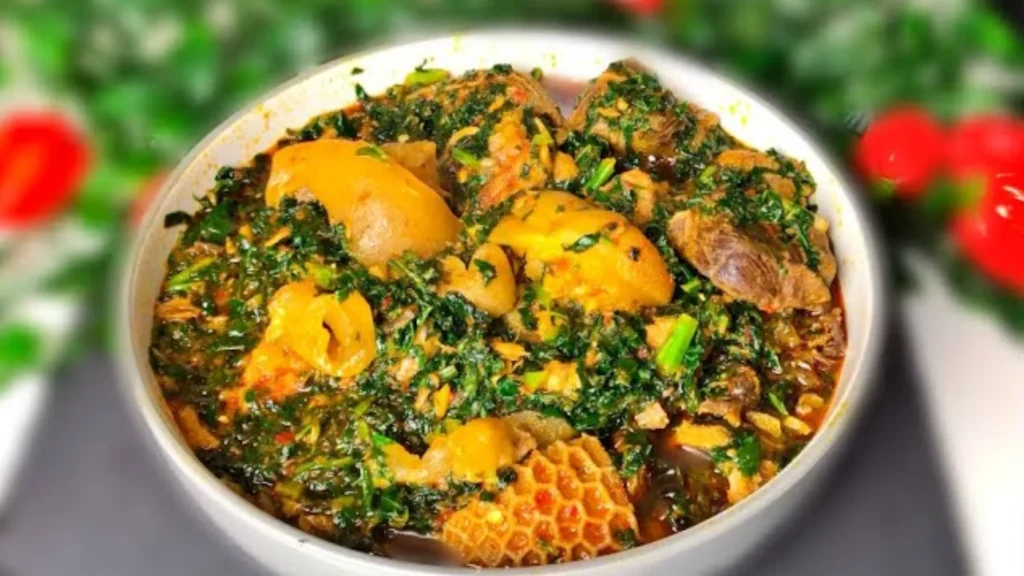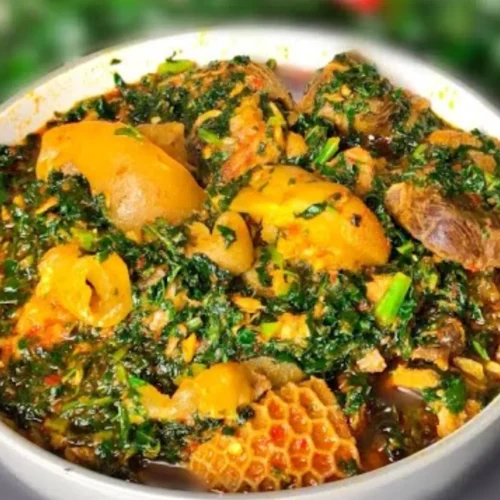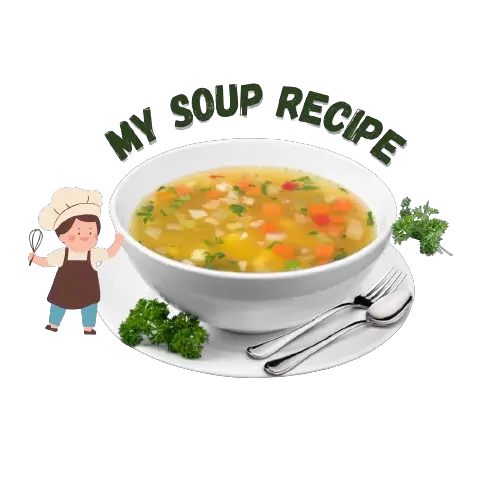Nigeria vegetable soup recipe , commonly known as “Edikang Ikong,” is a cherished dish from the southeastern regions of Nigeria.
This hearty soup is packed with leafy greens, assorted meats, and seafood, offering a flavorful and nutritious meal that’s deeply rooted in Nigerian culinary traditions.
In this post, I’ll guide you through crafting this delightful soup, sharing personal insights and tips along the way.
How To Make Nigeria Vegetable Soup Recipe?
Preparation Time: 30 minutes
Cooking Time: 1 hour
Total Time: 1 hour 30 minutes
Course: Main Course
Cuisine: Nigerian
Yield: 6 servings
Equipment Needed
- Large cooking pot
- Cutting board
- Sharp knife
- Wooden spoon
- Measuring cups and spoons
- Blender or mortar and pestle
Ingredients
- 2 cups ugu leaves (fluted pumpkin leaves), finely chopped
- 2 cups waterleaf, finely chopped
- 1 pound assorted meats (beef, tripe, and cow skin), cleaned and chopped
- 1 cup periwinkles (optional)
- 1 cup dried fish, deboned and shredded
- 1 cup stockfish, soaked and shredded
- 1 cup crayfish, ground
- 2 cups palm oil
- 2 medium onions, chopped
- 4 cloves garlic, minced
- 2 tablespoons ground pepper
- 2 seasoning cubes
- Salt to taste

Instructions
1. Prepare The Ingredients
I start by thoroughly washing and chopping the ugu and waterleaf. It’s essential to rinse them multiple times to remove any sand or impurities. I also clean and chop the assorted meats, soak the stockfish until it’s soft, and shred the dried fish.
2. Cook The Meats
In a large pot, I combine the assorted meats with chopped onions, minced garlic, seasoning cubes, and a pinch of salt. I add enough water to cover the meats and cook them over medium heat until they’re tender. This usually takes about 45 minutes.
3. Add The Seafood
Once the meats are tender, I add the soaked stockfish, shredded dried fish, and periwinkles to the pot. I let them cook together for about 10 minutes, allowing the flavors to meld.
4. Introduce Palm Oil And Crayfish
I pour in the palm oil and add the ground crayfish to the pot. Stirring well, I let the mixture simmer for another 5 minutes. The palm oil gives the soup its characteristic rich color and depth of flavor.
5. Incorporate The Vegetables
I first add the finely chopped waterleaf, stirring it into the soup. After about 3 minutes, I add the ugu leaves. I mix everything thoroughly and let it cook for an additional 5 minutes. It’s important not to overcook the vegetables to retain their nutrients and vibrant color.
6. Season And Serve
I taste the soup and adjust the seasoning with salt and ground pepper as needed. Once satisfied with the flavor, I remove the pot from heat. The soup is now ready to be served hot.
Nutrition Facts Of Nigeria Vegetable Soup Recipe
- Calories: 450
- Protein: 35 g
- Fat: 30 g
- Carbohydrates: 15 g
- Fiber: 5 g
- Sodium: 600 mg
Serving Suggestions Of Nigeria Vegetable Soup Recipe
I love pairing this vegetable soup with traditional Nigerian staples like pounded yam, fufu, or eba.
The starchy accompaniment complements the rich and hearty soup, making for a satisfying meal. For a lighter option, serving the soup over steamed rice works wonderfully.
Tips And Variations Of Nigeria Vegetable Soup Recipe
Leafy Greens: If ugu and waterleaf are unavailable, spinach and lamb’s lettuce can serve as substitutes.
Protein Choices: Feel free to customize the protein selection. Chicken or goat meat can replace beef, and you can omit seafood if preferred.
Spice Level: Adjust the amount of ground pepper to suit your heat tolerance. I sometimes add a scotch bonnet pepper for an extra kick.
Thicker Consistency: For a thicker soup, reduce the amount of water used during cooking.
Is Nigerian Vegetable Soup Healthy?
Yes, Nigerian vegetable soup is healthy. It is rich in vitamins, minerals, and fiber. It contains leafy greens, proteins, and healthy fats.
It supports digestion and boosts immunity. The ingredients provide essential nutrients for overall health. I recommend using minimal oil and fresh vegetables for the best benefits.
Note
While palm oil is a traditional ingredient in this recipe, it’s high in saturated fats. If you’re watching your fat intake, consider using it in moderation or exploring alternative cooking oils.
Conclusion
Preparing Nigerian vegetable soup at home is a rewarding experience that brings a taste of West Africa to your kitchen.
By following these steps and incorporating personal touches, you can create a flavorful and nutritious dish that delights the senses. Enjoy the cooking process and savor every spoonful of this traditional delicacy.

Nigeria Vegetable Soup Recipe
Equipment
- Large cooking pot
- Cutting board
- Sharp knife
- Wooden spoon
- Measuring cups and spoons
- Blender or mortar and pestle
Ingredients
- 2 cups ugu leaves fluted pumpkin leaves, finely chopped
- 2 cups waterleaf finely chopped
- 1 pound assorted meats beef, tripe, and cow skin, cleaned and chopped
- 1 cup periwinkles optional
- 1 cup dried fish deboned and shredded
- 1 cup stockfish soaked and shredded
- 1 cup crayfish ground
- 2 cups palm oil
- 2 medium onions chopped
- 4 cloves garlic minced
- 2 tablespoons ground pepper
- 2 seasoning cubes
- Salt to taste
Instructions
Prepare The Ingredients
- I start by thoroughly washing and chopping the ugu and waterleaf. It’s essential to rinse them multiple times to remove any sand or impurities. I also clean and chop the assorted meats, soak the stockfish until it’s soft, and shred the dried fish.
Cook The Meats
- In a large pot, I combine the assorted meats with chopped onions, minced garlic, seasoning cubes, and a pinch of salt. I add enough water to cover the meats and cook them over medium heat until they’re tender. This usually takes about 45 minutes.
Add The Seafood
- Once the meats are tender, I add the soaked stockfish, shredded dried fish, and periwinkles to the pot. I let them cook together for about 10 minutes, allowing the flavors to meld.
Introduce Palm Oil And Crayfish
- I pour in the palm oil and add the ground crayfish to the pot. Stirring well, I let the mixture simmer for another 5 minutes. The palm oil gives the soup its characteristic rich color and depth of flavor.
Incorporate The Vegetables
- I first add the finely chopped waterleaf, stirring it into the soup. After about 3 minutes, I add the ugu leaves. I mix everything thoroughly and let it cook for an additional 5 minutes. It’s important not to overcook the vegetables to retain their nutrients and vibrant color.
Season And Serve
- I taste the soup and adjust the seasoning with salt and ground pepper as needed. Once satisfied with the flavor, I remove the pot from heat. The soup is now ready to be served hot.
Notes

Hello! I am Shikha, I am a soup recipe maker. I have a lot of passion for making soup. With a journey spanning over five years in the culinary industry, I have carved a niche for myself as a distinguished soup maker whose creations are not just meals but experiences that linger on the palate and nourish the soul. My specialization in soup-making is a testament to my creativity and relentless pursuit of perfection. Beyond my skills in the kitchen, I am an avid writer, passionately sharing my knowledge and insights into nutrition through my writing. My approach to soup-making is holistic, emphasizing each ingredient’s taste and health benefits. A well-made soup can be a cornerstone of a healthy diet, providing essential nutrients while pleasing the taste buds.
